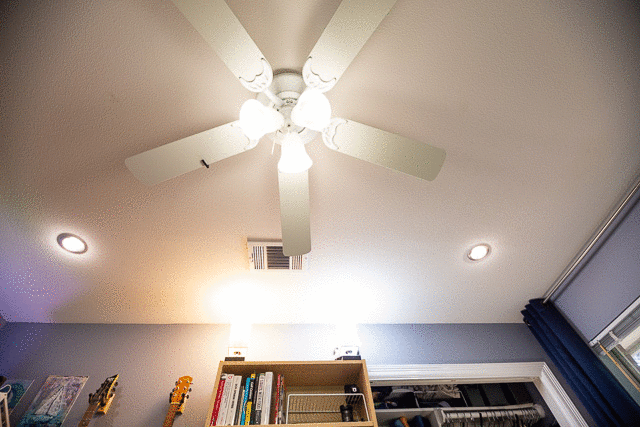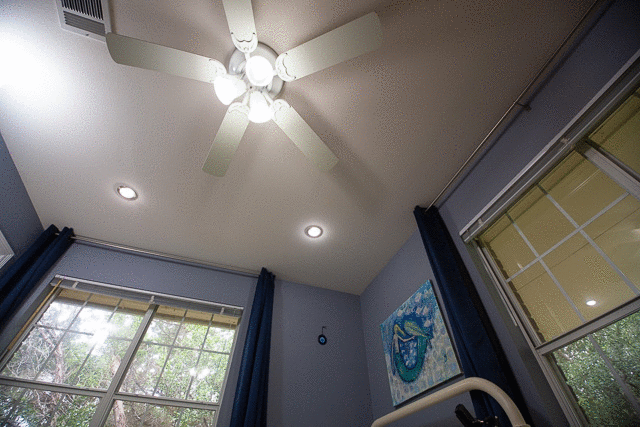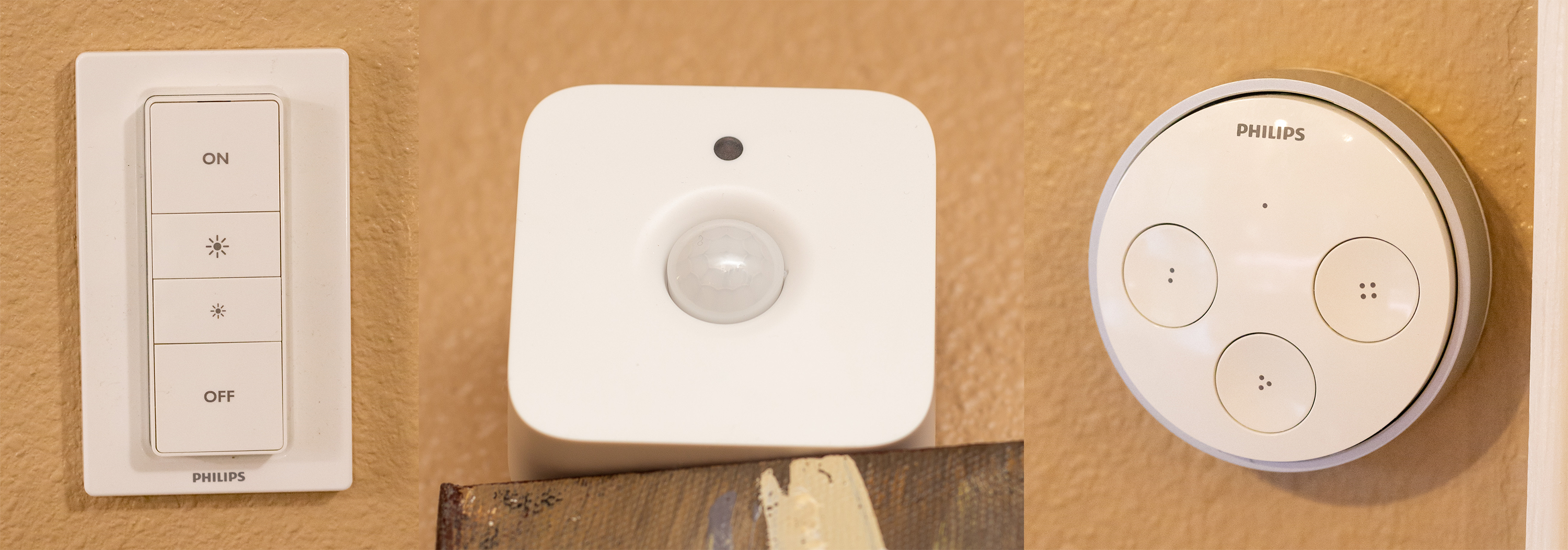Adventures in interior lighting
Upd:
Table of Contents
Introduction
Light is underappreciated as a way to improve the quality of an indoor environment. The technology has only gotten to the point relatively recently where the energy cost and technology make it feasible to implement adaptive lighting setups with the output to sufficiently light an interior space.
I'm in front of the computer a lot and spend too much time indoors, so indoor light quality has a disproportionate impact on my mood. Good incentive to understand how it impacts mood, energy levels, and sleep quality.
Based on my experience, the areas of opportunity are in matching color temperature to time of day, improving the Color Rendering Index, increasing lumen output during the day, and automation.
More lumens

Replicating the feeling of sunlight indoors—except at a tolerable light level—should be a goal of good indoor lighting. Most home lighting I've seen has insufficient light output. This isn't surprising, since the energy requirements per lumen didn't come down until recently, when high-output LEDs became relatively inexpensive, and most homes in the US are still designed for incandescent lighting. In an ideal world, Solar tubes and big windows would be common, but both are expensive and not appropriate in all climates.
An article on Hacker News last year outlined an experiment with a 250W corn cob LED bulb to augment indoor light levels. The 250W model seemed extreme for me, so I went with a pair of 60W bulbs at 2700K (no longer available, so here's 3000K) and 6000K. The smaller bulbs avoid the mogul screw base, the fan noise, and allow me to use a relatively normal lamp. I pair these with a ZOOZ ZEN25 double Z-Wave plug for control, so I get 6000K in the morning, ~4400K during the day (with both bulbs on), and 2700K in the afternoon. They're set to turn on with the room light switch based on the time of day. Starting with cool white only at 0900, both at 1100, warm white only at 1600, and off at 1800.
I've noticed a meaningful difference in my energy levels and focus during the day with the additional lighting. It's important to be careful with these, though, as it'd be easy to screw up your circadian rhythm keeping them on too late in the day or at night.
The core disadvantages to this approach are the lack of good light fixture options to support bulbs of this size (particularly 250W bulbs), the need for active cooling on the high output bulbs (which is noisy), the intensity of the single-source light (more diffusion is more comfortable), and the lack of built-in automation and color temperature adjustment. There's a market out there for a Hue-compatible Zigbee CCT corncob bulb in the 60–150W range.
More bulbs
A different approach is adding more light fixtures with regular bulbs. This eliminates the single-source problem by distribution the light across a living area. This is more expensive per lumen, particularly if you're buying lamps to scatter around a room with your new bulbs, though. Recessed lights or other ceiling fixtures are a good way to add light if you're DIY-inclined and at around $20 per fixture when self-installed are cheaper than lamps. You'll need 10 Hue A19 bulbs to match a single 60W corncob LED for lumen output (and a whopping 46 for a 250W bulb).
Color temperature adjustment

Matching light to time-of-day helps keep your body in sync with the day-night cycle. The obsolescence of incandescent bulbs improved energy efficiency, but we lost some benefits. Incandescents on a dimmer were great for adjusting light temperature, since the color temperature decreased as they were dimmed. A typical incandescent has a color temperature of about 3000K and is adjustable down to as low as 1800K when dimmed (basically candlelight). It also puts out a reasonably flat and complete color spectrum.
When everybody started switching to compact fluorescent bulbs, most dimming options went away entirely. Worse, the spiky color rendering of fluorescent bulbs suck the life out of everything. A house full of cool white compact fluorescents will put out a lot of light during the day for fewer Watts per lumen, but ends up harming sleep quality and appropriate tiredness in the evening.
LEDs at least improved the spectrum smoothness, but still had the issue of lack of dimming ability. When dimmable LED bulbs became more common, there was still no color temperature shift with dimming (minus an interesting experiment from Philips with a dumb CCT bulb that shifts temperature based on the dimmer input). 5000K white LEDs just do not look great dimmed.
Modern color-changing smart bulbs allow you to adjust color temperature directly (and separately from dimming). Hue bulbs have a white light range of about 2200K to 6500K (for the White and Color Ambiance and White Ambiance bulbs), which covers most of the usable range for indoor lighting. I have mine set for 6500K in the morning, 5000K during the day, 2700K in the afternoon, 2700K (dimmed) in the evening, and 2200K (minimum brightness) at night, which gives a nice color curve through the whole day to match the daylight cycle.
Both the bright daylight white during the day and the dim warm light during the evening help align circadian rhythms. The bright light during the day wakes you up and keeps you energized, while the dim light at night helps signal your body to wind down.
Hue bulbs are one of the more expensive bulbs to achieve color temperature switching. More recently, Philips released SceneSwitch dumb bulbs that cycle color temperature with each toggle of the switch. I don't have any direct experience with these, but at 20% of the cost of one Color and White Ambiance Hue A19 bulb, they're probably worth experimenting with if you're not prepared to pay the premium for smart bulbs.
Color Rendering Index (CRI)
The biggest regression when compact fluorescents started replacing incandescent bulbs was the reduction in CRI. This was made worse by fluorescent light's uneven, spiky spectrum rendering. LEDs have improved on fluorescents a great deal, but only the highest quality bulbs compete with incandescents for color rendering. Most people will be satisfied with a CRI of at least 80 and, for common use, CRIs above 90 tend to have marginal utility unless you have particularly sensitive color perception or are doing color-dependent work.1
The best smart bulbs (like Hue) only offer a CRI of about 80. You'll need to go to a specialty vendor like Yuji LED for better CRI and forego most of the smart features, as nobody is making $80 high-CRI smart bulbs.
That said, Philips' 80 CRI passes the acceptability threshold and won't be noticed by most people. Their bulbs have a more favorable spectrum distribution compared to many other LED bulbs with similarly CRI ratings, in my experience, which makes the color rendering limitations a bit less noticeable than I'd expect given the rating.
Automation

As lighting needs change with the time of day, both lumens and color temperature, the lighting system needs to adjust with it. Smart bulbs with CCT makes this possible, but it's the automation that makes it convenient and ensures you actually use the features.
My automation setup has three major parts:
- Smart switches (Hue dimmers and Tap switches)
- Motion sensors
- Home automation software.
Smart switches
The smart switches use time-of-day rules configured in the Hue hub to set which scene is selected for a given room for each time of day. I recommend using a 3rd party application for configuring this, as you'll have to use the Hue Labs formula if you use the Hue app and the number of time slots is limiting. This way, when you press the on button, it automatically goes to your selected scene for the given time slot.
Motion sensors
Motion sensors work the same way, except I use these in transitory areas like hallways to turn on and off the lights automatically. The time slots are nice at night because you'll get a dim, warm nightlight that won't blind you if you get up to go to the bathroom late at night.
Home automation software
The Hue hub is fairly capable automation-wise, but can't compete with dedicated systems. More complex rules, and integrating Z-Wave devices (like the dual plug switch I use for my bright corn cob LEDs), will require a better automation system like Home Assistant, OpenHAB, Domoticz, etc. Integrating Hue into these systems is pretty painless and you only need to add it as a layer on top of the built-in hub automation. Time-of-day rules and other stuff handled within the hub itself doesn't need to be touched by the home automation system.
Go outside

Ultimately, indoor light will never be as good as natural sunlight, nor is it a substitute for it. Sunlight is good for mood, good for health, and just all-around worthwhile (in appropriate doses tailored to the time of year, atmospheric conditions, and latitude—just don't burn!). Getting sunlight is a great excuse to take a break around midday and step away from whatever you're working on for a time.
Personally, I try to get between 15 to 30 minutes of full sun every day while maximizing skin exposure. I feel better and my Vitamin D levels are better, plus a little bit of skin color is always welcome.
Conclusion
- Add lumens (more bulbs, bigger bulbs, or both).
- Match artificial lighting color temperature to the time of day.
- Use high-quality bulbs with good color rendering.
- Automate.
The above combined with good sleep hygiene makes a night-and-day difference for my wellbeing. I am awake and energized during the day and appropriately sleepy at night. A lot of the gear outlined above is expensive, but you can always start small with just few bulbs to see how they work for you and resell them if you don't like the approach.
-
Color Rendering Index (CRI) is the measure of a light source's ability to render the colors of objects faithfully compared with natural light sources. ↩